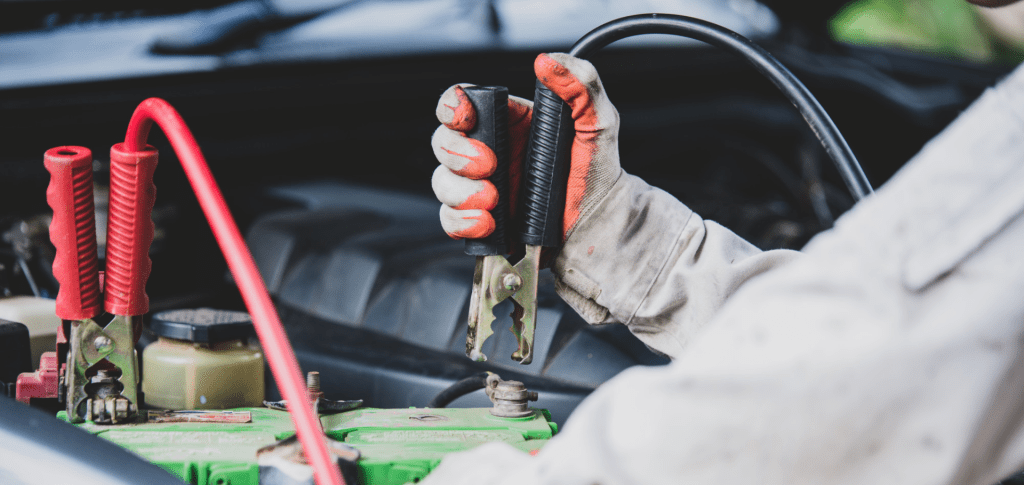Compare cheap breakdown cover
✔ Local, nationwide and European cover options
✔ Compare prices and choose the right policy for you
✔ Cover for cars, vans and motorbikes and scooters


If your car fails to start after turning on the ignition, it’s likely that the battery has gone flat. However, you can still revive it with the help of a friend, a functioning car, and a pair of jump leads. Follow these steps to jump-start your car and get it running again.
- Should I jump-start my car?
- How does jump-starting work?
- What you need to jump-start a car
- Jump-starting a car step-by-step
- What if jump-starting doesn’t work?
Should I jump-start my car?
If your car fails to start due to a flat battery, you might be wondering whether jump-starting it is a good idea. Jump-starting your car involves connecting your car’s battery to another car’s battery using jumper cables to get it working again.
While it’s a straightforward process, it requires handling electrically-charged components and can pose some risks.
This guide gives you a general idea of how to jump-start a car. Make sure you check your car manual before you start as things can vary between vehicles.
How does jump-starting work?
Jump-starting is a process of providing a quick boost of electrical charge from a functioning car’s battery to a car with a flat battery to start its engine.
In petrol or diesel vehicles, the battery charges up when the engine runs. If the battery’s charge has gone down due to leaving the lights on overnight or exposure to cold weather, jump-starting using jump leads can get the engine started again.
Once the engine starts running, the car’s alternator takes over, and it starts charging the battery. Driving the car around helps the battery to charge up fully.
It’s important to note that jump-starting is only suitable for conventional petrol or diesel engines. If you have an electric or alternative fuel vehicle, jump-starting is not appropriate and can even damage the vehicle’s electrical system. In such cases, you should seek professional help.
Compare cheap breakdown cover
What you need to jump-start a car
Jump-starting a car requires specific tools and safety precautions to ensure that you do not cause any harm to yourself or your vehicle. Here are the things you need and safety musts to keep in mind when jump-starting your car:
Things you need:
- A fully-working petrol or diesel car with the same voltage as yours (usually 12 volts)
- A set of jump leads in good condition
- A safe place to park both cars nose-to-nose
- Another person to hold the other ends of the leads while you attach them
- A torch if it’s dark
Safety musts:
- Never attempt to jump-start a battery that is leaking or visibly damaged. It can lead to an explosion or a fire hazard.
- Ensure that the clamps on the ends of the leads do not touch each other while you are making the connections. Ask the other person to hold the ends of the leads until all connections are made.
- If the jump leads start getting hot, stop using them immediately.
- When making connections, ensure that the black (negative) lead is only attached to the other car’s battery and not to yours.
It’s essential to follow these safety precautions to prevent accidents or damage to your vehicle’s electrical system.
Additionally, before jump-starting your car, you must ensure that your car’s battery is compatible with the other car’s battery. While most cars have a 12-volt battery, it’s best to double-check the voltage to ensure that you’re using the correct jump leads.
Finally, it’s crucial to keep in mind that jump-starting is only a temporary solution to a flat battery. If you find yourself needing to jump-start your car frequently, it may be time to replace the battery or have it checked by a professional mechanic.
Jump-starting a car step-by-step
Jump-starting a car involves several steps, and it’s crucial to prepare and take necessary precautions to ensure your safety. Here are the steps involved in the first stage of jump-starting a car:
Stage 1: Prepare
Find a safe location to park both cars nose-to-nose, ensuring that they are not touching.
Engage the parking brakes and switch off both engines. Remove the keys from the ignitions.
Open the bonnets of both cars and locate the battery terminals. It’s essential to know where the terminals are before you start jump-starting the car.
To avoid conducting electricity, remove any metal objects you’re wearing or have in your pockets, such as rings, keys, watches, or belt buckles. Tie back any long hair and tuck away any loose clothes that could pose a safety hazard.
Stage 2: Connect the jump leads
Connect one end of the red (positive) jumper cable to the positive terminal of the functioning car’s battery.
Connect the other end of the red (positive) jumper cable to the positive terminal of your car’s battery.
Connect one end of the black (negative) jumper cable to the negative terminal of the functioning car’s battery.
Connect the other end of the black (negative) jumper cable to an unpainted metal surface on your car, such as the side of the engine bay. Ensure that the metal surface is not near the battery and is a good grounding point.
It’s important to note that the order of connections is crucial to prevent damage to your car’s electrical system. Additionally, if the battery terminals look corroded, give the connected clamps a twist to ensure a good metal-to-metal connection.
Stage 3: Turn on the power
Wait for three to five minutes, then start the engine of the functioning car (the car with the fully charged battery).
Allow a few minutes for the power to transfer into your car’s battery.
Start your car’s engine. If it doesn’t start, wait a few more minutes for the battery to charge further.
Let both engines idle for around 10 minutes to allow the alternator to recharge the battery.
Switch off both engines and disconnect the jumper cables, reversing the order you connected them in. Start by removing the black (negative) lead from your car first, and take care not to let the clamps touch until you’ve disconnected everything.
Start your engine again and take your car for a drive for about 30 minutes to fully charge up the battery. This step is crucial to ensure that your car’s battery is sufficiently charged to start your car the next time you need it.


What if jump-starting doesn’t work?
If jump-starting your car doesn’t work, it’s an indication that you might have a different issue at hand. While a flat battery is a common reason why cars fail to start, there could be other underlying problems.
If your car’s battery isn’t holding a charge even after jump-starting, it’s possible that your car’s alternator is faulty. The alternator is responsible for charging your car’s battery while the engine is running. If the alternator isn’t working correctly, it can lead to a flat battery.
Another reason why your car’s battery may not hold a charge is that it may be at the end of its life and need to be replaced. Car batteries have a lifespan of around three to five years, and if your battery is nearing the end of its life, it may not hold a charge, even after jump-starting.
In such cases, it’s best to have your car checked by a professional mechanic to diagnose the issue accurately and determine the best course of action. Ignoring the problem can lead to more significant issues down the road, so it’s essential to address the problem as soon as possible.










